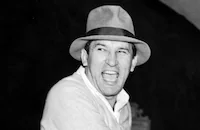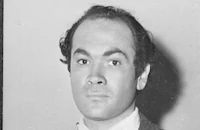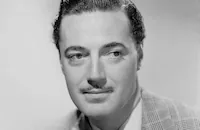Elephant Walk

Brief Synopsis
Cast & Crew
William Dieterle
Elizabeth Taylor
Dana Andrews
Peter Finch
Abraham Sofaer
Abner Biberman
Film Details
Technical Specs

Synopsis
In Shillingworth-on-Thames, England, book shop clerk Ruth has high hopes for her upcoming marriage to John Wiley, the owner of a Ceylon tea plantation, despite having known him for only two weeks. Upon arriving at Elephant Walk, John's plantation, Ruth is thrilled to discover that John's "bungalow" is an exotic mansion filled with servants, including John's devoted head servant, Appuhamy. Troubling her, however, is the fact that John's father Tom deliberately built the mansion across the path long taken by elephants on their way to the river and constructed a wall to keep them at bay. John's violent hatred of one particular bull elephant surprises Ruth, and she is also startled to learn that Tom is buried in a lavish marble grave behind the house, while John's mother is buried in England, because, according to Appuhamy, she hated Ceylon. Soon after his return, John's friends, fellow English planters and his American overseer, Dick Carver, drop by the house to meet Ruth. The men welcome Ruth, the only white woman in the area, then proceed to get drunk while toasting the greatness of John's father. Dick, who is leaving for Paris the next day, assures Ruth that Tom was more vain than heroic and counsels her not to take his legacy too seriously. Later, Ruth is awakened in the middle of the night by the sound of John and his friends playing polo on bicycles across the mansion's spacious floors. When Ruth tells John she was frightened by the noise, he coldly dismisses her fears as childish. Ruth runs crying back to her bedroom, and suddenly shamed, John follows and apologizes. The next day, Ruth notices Appuhamy praying at the foot of Tom's grave and tours the enormous kitchen with him. Appuhamy shows Ruth the items that were special favorites of "the old master," which are still being purchased, and balks when she offers to plan the menu so as to reduce the amount of waste generated by the plantation. Appuhamy also refuses to give Ruth the key to Tom's old study, piquing Ruth's curiosity. That night, Dick stops by to say farewell and, before going, encourages Ruth to contact him if she needs help. Later, John fractures his leg while drunkenly playing bicycle polo and is confined to his bed. During his convalescence, Ruth tries to sneak into Tom's study but hides when Appuhamy appears. After overhearing Appuhamy declare to a portrait of Tom that Ruth "does not belong" at Elephant Walk, Ruth learns from John's doctor that John's belligerent attitudes are impeding his recovery. Ruth writes to Dick for help, and he quickly returns and resumes his work as overseer. John's mood does not improve, however, as the expected monsoons have not started and the elephants have become agitated over the lack of water. When John yells at her for changing his lunch menu without permission, Ruth rushes to Dick, and while out riding with him, confesses that John is still ruled by his dead father. Dick kisses Ruth, who, despite her attraction, pulls away, protesting that she still loves John. Back at the plantation, John apologizes to Ruth and tries to appease her by announcing a special upcoming celebration. The celebration turns out to be an elaborate birthday party for Tom, and Ruth finally explodes with frustration, ordering John's drunken friends out of the house. The next morning, John condemns Ruth for driving his friends away and, when she insists that he hates Tom as much as she does, slaps her. Stunned, Ruth runs to Dick's quarters and begs him to take her to Paris. At the same time, however, one of John's servants collapses with cholera and the plantation is placed under quarantine. Trapped at Elephant Walk, Ruth and Dick toil long hours to help John curb the epidemic and soothe the terrified workers. When John, who is aware of Ruth's plans to leave him, insists on burying the dead himself, Ruth is impressed by his selfless dedication. Later, after the quarantine is lifted, Ruth tells Dick that she cannot leave John before the rains come, despite Dick's protests that John has not changed. As a final precaution, the workers' huts are set ablaze, and the elephants, agitated by the fire, start to stampede. With no workers available to beat them back, the elephants crash through the plantation wall and storm the house. Appuhamy, who has finally recognized Ruth's true worth, rushes to alert her and is killed by an angry elephant. While crashing through the house, the elephants cause a fire to erupt, and John barely arrives in time to rescue Ruth. Just then, the rain starts, and as Elephant Walk burns to the ground, John and Ruth embrace and pledge to start a new life together.

Director

William Dieterle
Cast

Elizabeth Taylor

Dana Andrews

Peter Finch

Abraham Sofaer

Abner Biberman
Noel Drayton

Rosalind Ivan
Barry Bernard
Philip Tonge

Edward Ashley

Leo Britt
Mylee Haulani
Madhyma Lanka Nritya Mandala Dancers
Jack Raine
Victor Millan
Henry Carr
William Bengal Rau
Eddie Das
Jiva Raj De Alwis
Reginald Lal Singh
Charles Heard
Norma Barden
Rodd Redwing
Carlos Rivero
Adolfo Ornelas
Leslie Sketchley
Delmar Costello
Satini Puailoa
Emmy, An Elephant
Crew
Irving Asher
Howard Beals
Sam Comer
John Cope
Francisco Day
Farciot Edouart
John P. Fulton
Alvin Ganzer
Ram Gopal
Grace Gregory
Loyal Griggs
Edith Head
Joseph Macmillan Johnson
Wallace Kelley
Paul Lerpae
John Lee Mahin
Gene Merritt
Charles Morton
Richard Mueller
Hal Pereira
Irmin Roberts
George Tomasini
Franz Waxman
Wally Westmore

Videos
Movie Clip



Film Details
Technical Specs

Articles
Elephant Walk
The plot of Elephant Walk is somewhat similar to Rebecca (1940), with Elizabeth Taylor as the new bride whom Peter Finch brings home to his ancestral tea plantation in the Ceylon jungle. He doesn't pay her any attention, however, preferring to slack around with his buddies (indoor bicycle polo, anyone?), and naturally Taylor starts to fall for the plantation foreman, played by Dana Andrews. The film's title comes from the fact that the plantation was built smack in the middle of the elephants' ancient jungle pathway. A violent climax features the massive beasts stampeding the property as they reclaim their right of way.
Producer Irving Asher originally wanted Laurence Olivier and Vivien Leigh to star in this picture, but Olivier disliked the script, turned it down, and encouraged his wife Vivien to do the same. When she signed on despite his objections, Olivier recommended Peter Finch to play the husband. Finch was Olivier's protégé, still unknown in Hollywood, but ultimately he got the part.
Once on location, he also embarked on a passionate affair with his mentor's wife. That would pose the least of the problems for producer Asher, however, as Leigh's mental state quickly deteriorated. A manic-depressive, she started hallucinating, addressing Finch as "Larry," and showing bizarre confusion about where she was. She even mixed up lines of Blanche Dubois's dialogue from A Streetcar Named Desire with her lines for this film. Olivier was called to the location to see what he could do but his visit was in vain. (Their marriage was already troubled and would end in divorce six years later.) Finally, after about three weeks, Leigh was flown back to Hollywood to recuperate, but it was already clear that she would have to be replaced. Paramount was losing a lot of money because of the delays and had to press on. (On the flight back, Leigh had a particularly bad mental attack, screaming and trying to open the plane door, and had to be sedated.)
Leigh's wildly shifting moods had already prompted director William Dieterle to shoot her scenes twice, including versions in which Leigh was far enough in the background that the shot could still be used if she was replaced. (Indeed, some of these shots remain in the picture.) He also framed some shots with her back to the camera for the same reason and shot some scenes without her at all, so that the footage could be used as background for process shots.
Dieterle's intuition proved correct. Asher got Paramount to replace Leigh with MGM star Elizabeth Taylor, even though at age 21 she was almost twenty years younger than Leigh. MGM took extreme advantage of the situation charging Paramount an astronomical $150,000 for the loanout.
Taylor had recently given birth to her first child, and Edith Head's costumes had to be refitted for the bustier actress; a few had to be remade altogether. Taylor idolized Leigh. According to biographer Donald Spoto, she said of her: "Vivien Leigh was my heroine. She was innocence on the verge of decadence, always there to be saved."
Of Taylor's performance here, Spoto wrote: "Elizabeth made a virtue of necessity, turning her underwritten character into a small miracle of slightly subdued sexual hysteria and shining, in glorious Technicolor, against the most unlikely projected backgrounds."
It's a little hard to believe that Finch's character would ignore his wife as played by the stunning Elizabeth Taylor, which Asher later acknowledged: "[I was] faced with an almost impossible situation," he said, "because in the original story there was a shrew who really created problems for her tea-planter husband. He would rather stay downstairs and play childish games with the boys, like riding around on bicycles, than face the scorpion Vivien waiting for him to go up to bed with her....Vivien was absolutely perfectly cast. She just had to stand there and tacitly demand his presence. The camera did the rest. But Elizabeth, extremely young then, and simply magnificent to look at, coming down in a negligee, trying to get Peter to come up with her, just didn't ring true. There isn't a man on earth who wouldn't have raced up those stairs!"
The impressive elephant stampede took some time to pull off. The elephants were so well-trained, Finch observed, "they could step on a matchbox without breaking it." True enough, they had been trained never to touch anything, and now they were being asked to destroy a house. It took several hours to get them to do it, and they were helped by the fact that all the structures and furniture had been partially sawn apart in advance so they would crumble easily.
Producer: Irving Asher
Director: William Dieterle
Screenplay: John Lee Mahin, Robert Standish (novel)
Cinematography: Loyal Griggs
Film Editing: George Tomasini
Art Direction: J. McMillan Johnson, Hal Pereira
Music: Franz Waxman
Cast: Elizabeth Taylor (Ruth Wiley), Dana Andrews (Dick Carver), Peter Finch (John Wiley), Abraham Sofaer (Appuhamy), Abner Biberman (Dr. Pereira), Noel Drayton (Planter Atkinson).
C-103m. Closed captioning.
by Jeremy Arnold
SOURCES:
Alexander Walker, Elizabeth: The Life of Elizabeth Taylor
Donald Spoto, A Passion For Life: The Biography of Elizabeth Taylor
Elaine Dundy, Finch, Bloody Finch
Trader Faulkner, Peter Finch

Elephant Walk
Quotes
Trivia
Vivien Leigh was originally cast. Her mental illness begun affecting things during filming, and so she was replaced by 'Taylor, Elizabeth' . Many long shots and shots from behind are still of Leigh.
Notes
The film opens with Peter Finch as his character "John Wiley" reciting offscreen the first few paragraphs of Robert Standish's novel Elephant Walk. Contemporary news items add the following information about the production: In October 1951, Dougfair Productions, a company owned by Douglas Fairbanks, Jr. and Alexander Macdonald, acquired the screen rights to Standish's novel as a vehicle for Fairbanks and Deborah Kerr. In June 1952, Dougfair relinquished the property to Paramount in order to concentrate on television production, and Irving Asher, who had been stationed in Ceylon (now Sri Lanka) during the war, was assigned to produce. Fairbanks, who had already made arrangements with the British, Ceylonese and Indian governments, agreed to stay on as a consultant, but the extent of his contribution to the final film has not been determined.
In January 1953, Paramount announced that Dana Andrews was to co-star with Vivien Leigh, after plans to co-star Leigh with her then husband, Laurence Olivier, fell through. Olivier, who had just starred in Paramount's Carrie, turned down the role after reading the script and meeting with Asher in London. According to modern sources, Olivier then recommended Peter Finch, a complete unknown in Hollywood, for the part. Elephant Walk marked Australian-born Finch's American motion picture debut. Principal photography began in Colombo, Ceylon, in early February 1953, but after the company returned to Los Angeles a month later, Leigh, who suffered from manic depression, had a complete breakdown and was removed from the film in mid-Mar. Although her doctors declared that the breakdown was the result of the long flight from Ceylon and Leigh's fear of flying, some contemporary reports, as well as modern sources, note that Leigh's erratic behavior was evident at the start of production.
A few days after Leigh's departure, Elizabeth Taylor, Jean Simmons and Claire Bloom were announced as Leigh's possible replacement. Paramount cast Taylor and paid M-G-M $150,000 for the loan-out. Modern sources claim that Asher had actually offered Taylor the role before Leigh, but that she had turned it down due to pregnancy. Because Taylor was about the same height as Leigh and the Ceylon footage featured Leigh only in long, establishing shots, most of the Ceylon footage (ninety percent, according to modern sources) was retained in the final film. In order to match up shots of Leigh and Taylor, Leigh's wardrobe had to be refitted or replaced, as Taylor was a bit heavier than Leigh, and Taylor had to wear a wig to cover her "poodle" haircut.
Elephants used in the picture were borrowed from the Cole Brothers Circus in Chicago. Emmy, a female elephant, was fitted with false tusks for the production, and a mechanical trunk was constructed for one of the stampede shots. Modern sources note that furniture on the plantation set was partially sawn away to facilitate its destruction during the rampage scene, but that the elephants initially balked at orders to wreck the place. A Hollywood Reporter news item adds E. A. Gould-Porter to the cast, but his appearance in the final film has not been confirmed. According to the Time review, the film's budget was approximately $3 million. Taylor required eye surgery after a piece of metal, thrown by a wind machine, damaged one of her eyes during a publicity still session, according to modern sources. On May 3, 1955, Joan Fontaine, John O'Malley and Les Tremayne appeared in a Lux Radio Theatre version of the story.

Miscellaneous Notes
Released in United States on Video June 10, 1991
Released in United States Spring April 1954
Vivien Leigh was replaced by Elizabeth Taylor but there are still some long shots of her in the film.
Released in United States Spring April 1954
Released in United States on Video June 10, 1991













